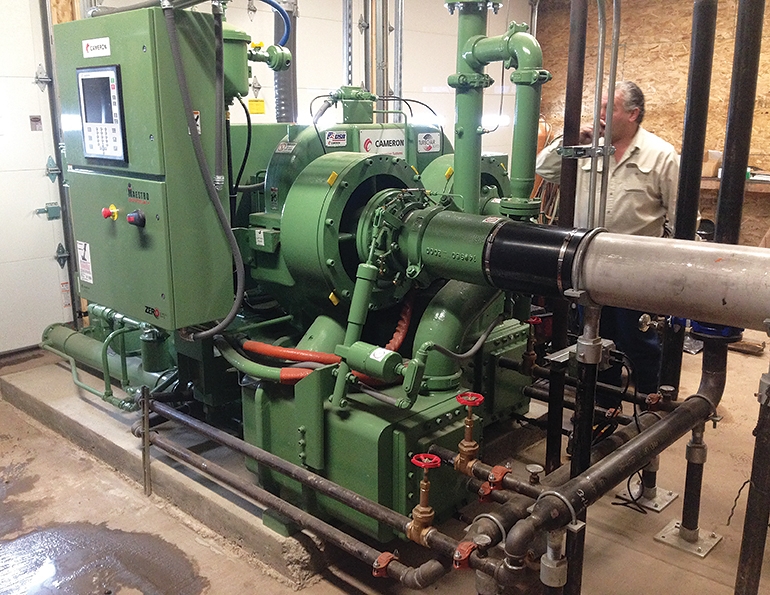Most snowmaking infrastructure is not visible to the general public. Snow guns tend to steal the spotlight, both for their visibility and recent technological advances. But water pumps and air compressors are tasked with delivering the vital raw materials to the snow guns through a mountain’s pipelines—and they do it without much fanfare.
Water pumps and air compressors represent relatively mature technology that haven’t undergone the major, rapid advances as compared to snow guns. However, in recent years, many installations have benefitted from upgrades that greatly enhance productivity and efficiency.
Air Compressors
Air compressor stations are an integral component to any air/water snowmaking system and oftentimes are one of the most vital components in early season, marginal-temperature snowmaking. Air compressors for snowmaking can be generally grouped into two categories: rotary screw and centrifugal.
During the late ’70s and ’80s, rotary screw compressors dominated the marketplace with sizes typically in the 200-400 hp range. Virtually all of these machines were the oil-flooded variety. The oil provided lubrication, cooling, and, most importantly, sealing between the spinning screw “impellers.”
Starting in the late 1980s, centrifugal technology was introduced in snowmaking on a larger scale, and it continues to be the go-to. Most of these machines used in snowmaking range from 600 hp to 1250 hp in size. The centrifugal technology differs from rotary screw primarily in the type of “impeller” used. Instead of oil-sealed screws, the air is compressed with high-speed impellers, similar to turbochargers. The centrifugal compressors are all multi stage, typically with three stages of compression.
Centrifugal compressors have several key advances over oil-flooded rotary screw compressor technology.
More efficient. Centrifugal compressors are typically 15 percent more efficient on a cubic feet per minute (CFM) per horsepower basis. Contributing to this is how rotary screw compressors are rated. Most rotary screw compressors use 10-15 percent more than the nameplate horsepower rating of the compressor.
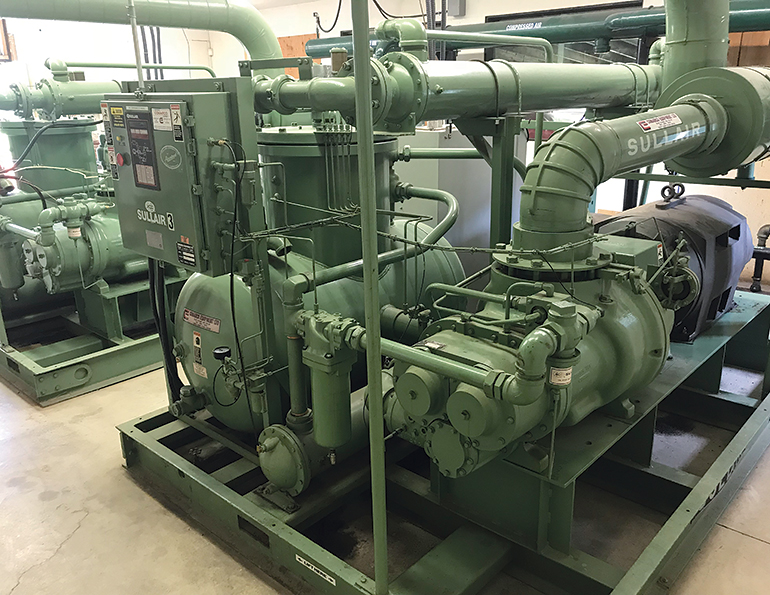 The capcaity of oil-flooded rotary screw compressors can shrink by 25 to 30 percent as the machines age.In addition, older rotary screw compressors suffer from performance degradation due to age. It’s not unusual for an existing rotary screw compressor’s capacity to measure 25 to 30 percent less than new compressor performance. Conduct a performance test on older rotary screw compressors to determine if such a disparity exists.
The capcaity of oil-flooded rotary screw compressors can shrink by 25 to 30 percent as the machines age.In addition, older rotary screw compressors suffer from performance degradation due to age. It’s not unusual for an existing rotary screw compressor’s capacity to measure 25 to 30 percent less than new compressor performance. Conduct a performance test on older rotary screw compressors to determine if such a disparity exists.
High performance. Rotary screw compressor published performance ratings are based on sea level installation. As site elevation increases, delivered performance will decrease. Since centrifugal compressor impellers are custom machined for the site conditions, the rated performance will not have to be de-rated for elevation.
Environmentally friendly. Centrifugal compressors also have environmental benefits due to their oil-free design. Oil-flooded rotary screw compressors utilize oil for sealing in the air end and therefore, oil is present in the airstream. After the air is compressed, most of the oil is removed and recovered by the compressor oil separator. However, a small amount does pass into the pipeline system, called “oil carryover.” The centrifugal technology is considered oil free.
More power, less space. Centrifugal compressors pack a lot of capacity into their size. For example, one 600 hp centrifugal compressor with a capacity of 3,000 CFM takes up half the space as two 300 hp rotary screw compressors with the same total capacity. This is an important factor in larger compressed air installations of 6,000-10,000 CFM or greater.
With the industry trend toward snow guns that use less compressed air, installations are not typically getting larger. But greater efficiency and eliminating oil carryover are two good reasons why resorts are switching from rotary screw to centrifugal compressors. Plus, utility rebates may be available to help defray cost.
Caledon Ski Club in Ontario, Canada, recently replaced three rotary screw compressors that had original total capacity of 3,750 CFM, but tests showed an average performance degradation of 30 percent as compared to new. Its new 500 hp centrifugal compressor has a 2,300 CFM capacity—comparable to what the old machines were producing before replacement—and uses at least one-third less power. The new installation also eliminated oil carryover, boosted productivity, and operates so efficiently that Caledon conservatively estimates it will save $30,000 in annual energy costs.
If the large capital expense of a new compressor is not in the cards, it is imperative to perform regular maintenance and, if possible, conduct performance testing to benchmark how existing compressed air delivery compares to current technology.
Water Pumping
Water pump technology has stayed virtually the same in recent years. However, systems are being upgraded to deliver higher pressures and volumes that current snow gun technology demands. Controls and monitoring connectivity are where most of the recent advancements in pump stations have occurred.
Sizing up. Over the past few decades there’s been a dramatic increase in the size of pumps being installed. Twenty years ago, a mainstream pump capacity was in the 500 gpm range using a 250 hp motor. Now, most new installations are 1,000 gpm pumps with 400-500 hp motors, and larger.
Mark Meadows of Torrent Engineering and Equipment sees this as a major trend in the marketplace, driven primarily by the utilization of more efficient snow guns, which can convert more water at particular temperatures. Meadows notes that ski areas are also striving to deliver a minimum pressure of 300 psi on the system in order to expand utilization of high efficiency snow guns. The need for higher pressures and greater capacities is the driver of the larger horsepower, high capacity pumps.
Re-fitting. Rick Chapman of Trask-Decrow Machinery (TDM) sees a similar trend with higher pump pressures and capacities. TDM works with multiple pump suppliers to provide good pump selections to optimize performance based on customer requirements. But Chapman has also seen demand for re-fitting existing pumps with higher-pressure bowl assemblies.
Keep in mind that pumps can be rebuilt to higher pressures as long as they meet the pump design pressure limit, usually dictated by the discharge flange rating. Most pumps are equipped with Class 300 flanges, which are rated up to 740 psi cold water pressure. By using the same motor, a higher pressure will come at the expense of gpm flow capacity. However, these retrofits can oftentimes be performed at half of the cost of new, and could be coupled with utility rebates if it results in greater utilization of high efficiency guns.
If the desired target pressure is above the 740 psi threshold, then a new pump equipped with Class 600 flanges is the way to go. If both greater flow and pressure are desired, then a new pump and motor will need to be considered.
Variable frequency drives. All pumping suppliers including Torrent, TDM, and Ratnik have seen increased utilization of variable frequency drives (VFDs), with a more recent trend toward installing multiple VFDs or VFDs on all pumps.
A VFD is an electronic motor controller that takes the place of a motor starter. The VFD controller can adjust the speed of the motor by varying the AC power frequency to the motor. A traditional VFD pump system has a single VFD controller with the balance of the pumps on constant speed motor starters.
In this configuration, for example, say a pump station has a series of 1,000 gpm water pumps and the snowmaking system is only consuming 500 gpm, the VFD would adjust the frequency and speed of the motor so that the pump would only deliver 500 gpm. If the demand increases to 1,500 gpm, one full-speed pump would turn on at 1,000 gpm and the VFD would again control one of the pumps at reduced 500 gpm capacity. When the pump VFD operates at a lower frequency and speed, it can save a considerable amount of energy over the course of a season.
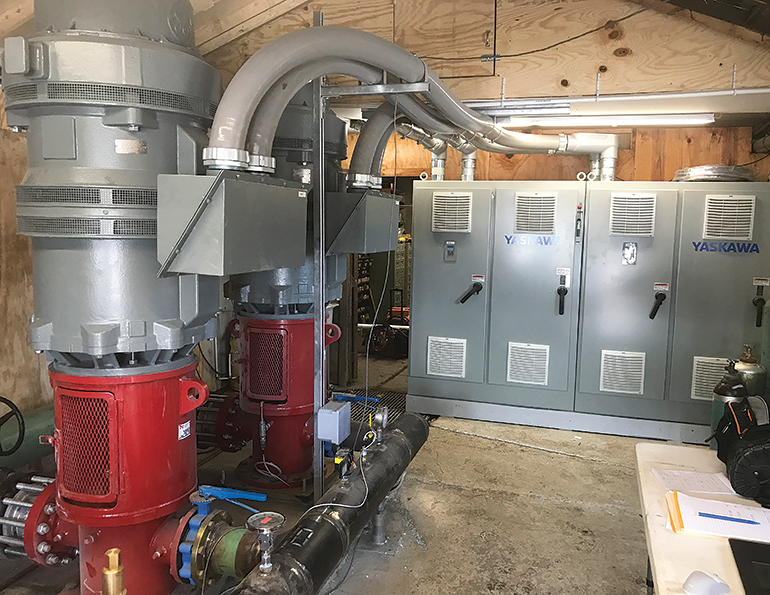 Multiple VFDs in the same pump house can be very beneficial to operations. Multiple VFDs in the same pump house can offer additional advantages. Having two VFDs provides system redundancy if one pump or VFD fails. Having VFDs on all pumps in a pump station can allow for wide ranging pressure set points. For example, pumps can operate at full capacity to generate 300 psi on top of the system, but if not operating at the top of the system, the pressure can be reduced to a much lower set point, saving considerable energy and keeping motor current at acceptable levels.
Multiple VFDs in the same pump house can be very beneficial to operations. Multiple VFDs in the same pump house can offer additional advantages. Having two VFDs provides system redundancy if one pump or VFD fails. Having VFDs on all pumps in a pump station can allow for wide ranging pressure set points. For example, pumps can operate at full capacity to generate 300 psi on top of the system, but if not operating at the top of the system, the pressure can be reduced to a much lower set point, saving considerable energy and keeping motor current at acceptable levels.
Generally speaking, most pump stations can benefit from VFD technology and realize energy savings and enhanced control. Older pump stations can be retrofitted, as long as the motor is in good condition and the pump does not have significant wear.
Connecting to the web. Internet or network connectivity has been virtually omnipresent in our daily lives, and water-pumping systems are no exception. More and more ski areas are connecting their pump stations on their internal computer networks, enabling managers to monitor the systems on-site or remotely.
Meadows says snowmaking managers now recognize the importance of “total system awareness” to help make rapid decisions that optimize productivity and efficiency. Many VFDs and control systems are now Ethernet based, enabling these components to be easily connected to ski area computer networks. This connectivity enables technicians to remotely troubleshoot or upload updated control system programs without the time and expense of on-site travel.
Rebuilding is an option. For ski areas on a budget, pump maintenance and rebuilding are good alternatives in order to maximize utilization of existing pump infrastructure. Over time, pumps will see wear in the impellers and bearings, which can cause performance degradation and vibrations.
To determine if pumps can benefit from being rebuilt, Chapman suggests technicians perform pressure flow tests on the pumps. The tests will generate a performance curve that is compared to the original design of the pump, and potentially show a performance gain if the pump were rebuilt. The results can also inform an overall growth and management plan for the pumping system, he says.
Rebuilding a water pump typically involves:
• disassembly and inspection
• replacement of shafts and bearings
• re-machining of impellers and bowls to bring worn tolerances up to original specification
• rebuilding mechanical seals
• sandblasting and painting for a like-new appearance.
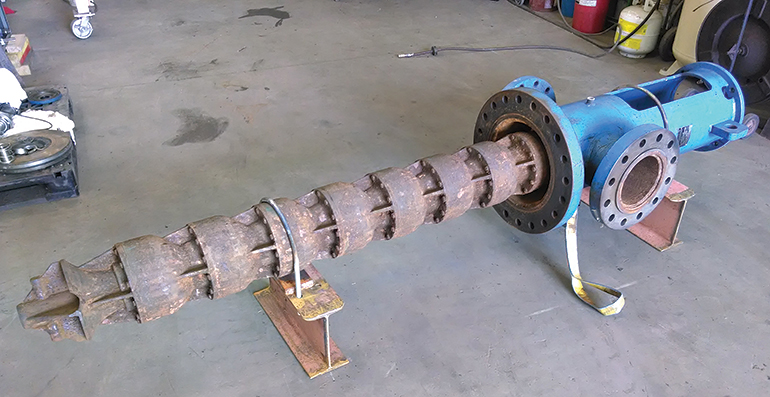
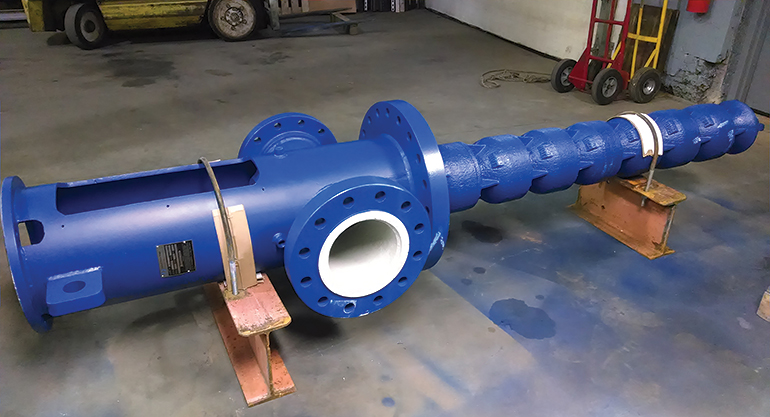 A pump (top) pre- and (bottom) post-rebuild.
A pump (top) pre- and (bottom) post-rebuild.
Pricing will vary, but is usually a fraction of the cost of a new pump. Depending on parts required, parts availability, and pump-shop workload, a rebuild can take 6-10 weeks from start to finish. This is an attractive timeframe, considering it takes 16-20 weeks to replace an old pump with a newly built pump of the same capacity.
The Long View
The demand for greater flow capacity, output pressure, and horsepower will continue to grow for the foreseeable future. Significant expansions can exceed certain infrastructure capabilities, such as pump intake structures, electrical services, and slope pipelines. It is important to consult with a qualified designer or engineer in order to evaluate the existing infrastructure as well as proposed expansions.
Permitting and electrical upgrades can take time. Typically, this requires planning a year or more in advance. Slope pipeline replacements to accommodate for larger capacity may be required, and if not performed properly, the desired impact of new equipment will not realize its full potential.
Although not the most prominent ski area infrastructure, snowmaking pumps and compressors are increasingly vital to ski area operations in order to keep up with market competition and climate trends. By investing in newer technology, ski area operators are seeing benefits in productivity, efficiency, and environmental impact.





